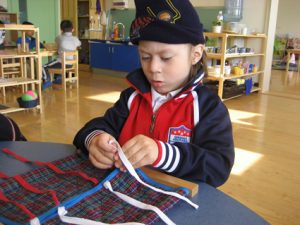Late 1900s: Montessori
Maria Montessori: The Montessori Method

Maria Montessori scientifically observed and measured the behaviors of young children which resulted in her development of The Montessori Method–an educational teaching method and philosophy. According to Montessori, a child’s mind is quickly developing within the first six years of life (“the absorbent mind”) whereby a child takes in as much as possible from one’s environment.[1]
Key hallmarks of The Montessori Method include self-directed, hands-on experiential learning, collaborative play, and freedom of movement and activity within a safe, multi-sensory environment. Trained teachers maximize these hallmarks by offering developmentally-appropriate activities that promote individualized learning to optimize children’s physical, cognitive, social, and emotional development.
Children work at their own pace and engage in free choice activities within clear, firm, reasonable, and developmentally-appropriate boundaries established by trained teachers. Montessori’s research deduced that these practices stimulate deeper learning experiences, independent thinking, problem-solving, creativity, confidence, and lifelong enthusiasm for learning.
Key Takeaways
- The “absorbent mind”—children are capable of taking in the maximum learning from their environment during the first six years of life.
- The Montessori Method emphasizes self-directed, hands-on, experiential learning, collaborative play, and freedom of movement in a safe and multi-sensory environment.
- Teachers offer developmentally-appropriate activities and foster individualized learning.
- Montessori, M. (1917). The Montessori elementary manual (A. Livingston, Trans.). Frederick A. Stokes Company. http://www.gutenberg.org/files/42869/42869-h/42869-h.htm ↵
Montessori is a method of education that is based on self-directed activity, hands-on learning and collaborative play. (Source: Montessori Northwest)

